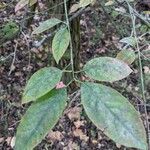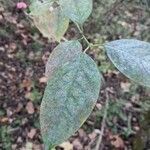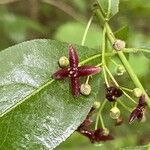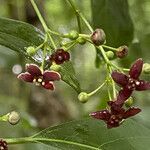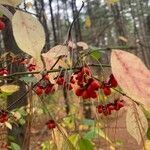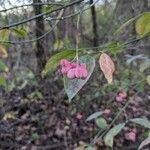A small deciduous tree. It grows up to 2.4-6 m high. It spreads 1 m wide. The bark is greenish-grey streaked with reddish-brown. The leaves are 5-12 cm long and oval. They have a long point. The leaf stalk is about 1 cm long. They turn red in autumn. The flower are small and purplish. The fruit are capsules about 10-14 mm across. They have 4 prominent lobes. These split to reveal the seeds. There are 4 seeds. Each seed is enclosed in a bright orange-red fleshy aril or seed layer. The fruit turn pink when ripe.
Erect shrub to 6 m, vigorously colonial by rhizomes; petioles 1–2 cm; lvs elliptic to lance-ovate, 6–12 cm, acuminate, finely serrulate, acute at base, finely hairy beneath, turning pale yellow in autumn, then deciduous; fls few–many in divergently branched cymes 2–4 cm wide on axillary peduncles 2–5 cm, 4-merous, brownish-purple, 6–8 mm wide; fr red, smooth, 1.5 cm thick, 4-lobed, sometimes 1–3 of the lobes reduced; aril bright red. Moist woods; N.Y. to N.D., s. to Fla. and Tex. June.
